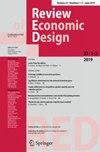有转售的拍卖中的价值排序解密
IF 0.5
4区 经济学
Q4 ECONOMICS
引用次数: 0
摘要
考虑一个有转售的单件拍卖和两个风险中性的投标人。竞买人和出价人都知道估值的排序,也就是说,竞买人知道估值最高和最低的竞买人的身份。我们的研究表明,当价值排名被揭示时,经典的 "出价对称 "结果并不成立。令人惊讶的是,估值最低的投标人的出价分布比估值最高的投标人更强。我们还证明,在有转售的拍卖中,价值排名的揭示会使出价策略不对称。最后,对于一个特殊的概率分布系列,我们证明了第一价格拍卖的收益优于第二价格拍卖。本文章由计算机程序翻译,如有差异,请以英文原文为准。
Unraveling of value-rankings in auctions with resale
Consider a single-unit auction with resale and two risk neutral bidders. The ranking of the valuations is known to both the bidders—that is, the bidders know the identity of the highest and lowest valuation bidders. We show that, when the value-rankings are revealed, the classic result of “bid symmetrization” does not hold. Surprisingly, the bidder with the lowest valuation produces a stronger bid distribution than the bidder with the highest valuation. We also show that the revelation of value-rankings in auctions with resale asymmetrizes the bidding strategies. Finally, for a special family of probability distributions, we show that the first-price auction is revenue superior to the second-price auction.
求助全文
通过发布文献求助,成功后即可免费获取论文全文。
去求助
来源期刊

Review of Economic Design
ECONOMICS-
CiteScore
0.80
自引率
28.60%
发文量
37
期刊介绍:
Review of Economic Design comprises the creative art and science of inventing, analyzing and testing economic as well as social and political institutions and mechanisms aimed at achieving individual objectives and social goals. In this age of Economic Design, the accumulated traditions and wealth of knowledge in normative and positive economics and the strategic analysis of game theory are applied with novel ideas in the creative tasks of designing and assembling diverse legal-economic instruments. These include constitutions and other assignments of rights, mechanisms for allocation or regulation, tax and incentive schemes, contract forms, voting and other choice aggregation procedures, markets, auctions, organizational forms, such as partnerships, together with supporting membership and other property rights, and information systems. These designs, the methods of analysis used in their scrutiny, as well as the mathematical techniques and empirical knowledge they employ, along with comparative assessments of the performance of known economic systems and implemented designs, all of these form natural components of the subject matter of Economic Design.
Officially cited as: Rev Econ Design
 求助内容:
求助内容: 应助结果提醒方式:
应助结果提醒方式:


